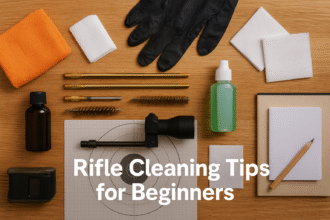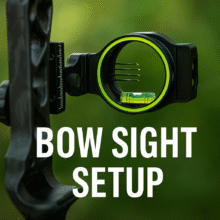Hunting Rifle Maintenance Checklist: A Complete Guide for Every Hunter

A hunting rifle is one of the most trusted tools in the field. It doesn’t matter whether you’re waiting silently in a hardwood forest for a whitetail buck, stalking mule deer across open terrain, or preparing for a week-long elk camp the performance of your rifle directly influences the outcome of every hunt. A rifle that misfires, loses accuracy, or develops rust at the wrong moment can turn a promising opportunity into a disappointment. That’s why consistent, proper maintenance is not an optional routine; it is an essential part of being a responsible and successful hunter.
Maintaining a rifle does not have to be complicated. The key is understanding what parts require attention, when to inspect them, and how to clean them properly. A reliable rifle is one that is cared for before the hunt, after the hunt, and again at the end of the season. This detailed guide walks you through a complete hunting rifle maintenance checklist from start to finish, explaining each step in a clear and practical way so you can keep your firearm functioning flawlessly every time you take it into the field.
Table of Contents
Pre-Hunt Rifle Inspection
Before you even think about stepping out of your truck or climbing into a stand, your rifle needs a thorough inspection. This routine ensures the firearm is safe, clean, and fully prepared for the conditions ahead. Begin by examining the overall condition of the rifle. You should visually inspect the stock, the barrel exterior, and the receiver for any signs of cracks, rust, or loose screws. A surprising number of accuracy problems come from something as simple as a loose action screw or a loose optic mount, so this inspection is more important than many hunters realize.
Once the exterior looks sound, check the barrel’s interior. Shine a light through the bore to ensure it is free from dirt, oil, moisture, or any foreign object. Even a small amount of debris can change the pressure inside the barrel and affect the consistency of your shots. If you notice anything unusual, run a dry patch through the bore to clear it before heading out.
Your next step is to examine your optics. A high-quality scope is only as good as the security of its rings and mounts. Gently check every screw or mounting point to confirm nothing has loosened. Wipe the lenses clean with a microfiber cloth to remove smudges, fingerprints, or moisture. While you’re checking your optics, review your zero. If your rifle was bumped, dropped, or stored for a long period, sight alignment may shift. Confirming zero before the hunt can prevent a missed shot in the field.
Now examine the bolt or action. Cycle it a few times to ensure it moves smoothly without grinding or sticking. A stiff bolt can indicate dried oil, dirt buildup, or lack of lubrication. Smooth action cycling is crucial for fast follow-up shots and consistent reliability. You should also test the trigger and safety. Make sure the trigger pull feels clean and consistent and verify that the safety engages and disengages properly.
Finally, inspect your ammunition. Look for tarnished brass, corrosion, dents, or damaged cartridges. Poor-quality ammunition can cause feeding problems, misfires, or inconsistent accuracy. Check the magazine as well to ensure rounds load and unload smoothly. Once all parts check out, your rifle is ready to accompany you into the field with confidence.
Post-Hunt Rifle Cleaning and Care
After a long day of hunting whether you faced rain, snow, dust, or just dry weather your rifle will have been exposed to environmental elements that can slowly degrade its performance. Proper post-hunt cleaning is the most important step in preserving your firearm.
The first rule is simple but essential: make absolutely sure your rifle is unloaded before beginning any maintenance. Remove the magazine, open the action, and visually and physically inspect the chamber. Once the firearm is safe, remove the bolt and begin cleaning the bore.
Cleaning the barrel requires both solvent and patches. Apply solvent and use a bore brush to break up powder residue, fouling, or debris that accumulated throughout the day. Continue passing patches through the bore until they come out clean. When the barrel is free of residue, finish with a lightly oiled patch to protect the metal from corrosion. Avoid using excessive oil inside the barrel because too much can affect pressure when firing the next round.
Once the bore is clean, move on to the action and receiver. Dirt, unburnt powder, and moisture often collect in these areas, especially after walking through brush or experiencing damp conditions. Use a nylon brush or cotton swabs to gently clean around the bolt face, extractor, chamber entrance, and trigger area. Clean off residue but use caution around the trigger assembly, as over-lubricating this part can cause reliability issues. Only a light touch of lubricant is necessary.
The exterior of the rifle also needs care. Wipe down the barrel, receiver, bolt handle, and any other metal surfaces with a thin coat of anti-corrosion oil to prevent rust. If you’re using a hardwood stock, dry it thoroughly and inspect it for cracks or swelling, especially if it has been exposed to water. A synthetic stock usually needs nothing more than a simple wipe, but it should still be checked for damage.
The final step in post-hunt maintenance is proper storage. Rifles should be stored in a cool, dry environment with low humidity. A gun safe with silica gel packs works well. Never store your rifle inside a soft gun case for an extended period; these cases trap moisture and can cause rust within hours.
End-of-Season Deep Maintenance
When the hunting season ends, your rifle needs one final, more thorough cleaning before it goes into long-term storage. This is the time to give it a complete inspection beyond the quick post-hunt cleaning.
Begin by performing a deeper disassembly. Remove the bolt, take out the magazine, and separate the rifle from the stock if you are comfortable doing so. This gives you access to hard-to-reach areas where moisture and debris may have collected unnoticed. Inspect the barrel crown carefully. Any dents or damage here can significantly affect accuracy. Look down the rifling with a bore light to check for copper fouling or rust. If copper buildup is present, use a specialized copper solvent to dissolve and remove it.
Once the internal parts are spotless, apply lubrication to all moving surfaces, but again, use restraint. Excess oil only attracts dust. A thin, even layer is all you need. Check the torque on every screw, especially the action screws and scope mounting screws. Temperature fluctuations during the season can loosen them over time, and even a minor shift can throw off your accuracy.
Before putting the rifle away for the off-season, apply a protective coating to all exterior metal surfaces and lightly oil the interior of the barrel. Store the rifle upright in a climate-controlled environment. If possible, check on it once every few weeks to ensure no moisture has accumulated.
Essential Rifle Maintenance Tools
Although maintaining a rifle doesn’t require a large workshop, having the right tools makes the job significantly easier and safer. A cleaning rod, bore guide, brushes, patches, solvent, and gun oil form the basic setup. A torque wrench is extremely useful for keeping your scope and action screws tightened to manufacturer-recommended specifications. Microfiber cloths are essential for cleaning optics, and a silicone-treated cloth is perfect for wiping down metal surfaces.
Final Thoughts
A hunting rifle is an investment that deserves consistent care. Proper maintenance not only extends the life of your firearm but also ensures it performs reliably when the moment of opportunity arrives. Whether you hunt once a season or every weekend, your rifle depends on you to keep it in top condition. By following a clear and thorough maintenance routine before the hunt, after each outing, and again at the end of the season, you’ll enjoy better accuracy, smoother operation, and complete peace of mind every time you step into the woods.






